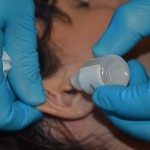Chapter 6. Non-Parenteral Medication Administration
6.5 Instilling Eye, Ear, and Nose Medications
Instilling Eye Medications

The eye is the most sensitive organ to which medication may be applied (Perry et al., 2018). The cornea is especially sensitive, making the conjunctival sac the appropriate site for instilling eye (ophthalmic) medications. Eye medications might be necessary for conditions such as glaucoma, infection, and following eye surgery. Of note is that eye medication are for the most part administered into the conjunctival sac, which is much less sensitive than the cornea.
Checklist 49 outlines the steps for instilling eye medications.
Checklist 49: Instilling Eye (Ophthalmic) MedicationsDisclaimer: Always review and follow your agency policy regarding this specific skill. |
|||
Safety considerations:
|
|||
Steps |
Additional Information |
||
| 1. Perform hand hygiene prior to medication preparation.
Check MAR to guide you to which medications you are preparing. Follow agency policy to ensure MARs are accurate and verified appropriately. |
 A MAR that is checked by more than one healthcare professional provides a very reliable record for administering medications. Agencies may vary in relation to MAR verification processes. |
||
|
2 a. As you are removing medication from the dispensing system, perform the SEVEN right three times with each individual medication:
|
The right patient: Check that you have the correct patient using two patient identifiers (e.g., name and date of birth). The right medication (drug): Check that you have the correct medication and that it is appropriate for the patient in the current context. The right dose: Check that the dose makes sense for the age, size, and condition of the patient. Different dosages may be indicated for different conditions. The right route: Check that the route is appropriate for the patient’s current condition. The right time: Adhere to the prescribed dose and schedule. The right reason: Check that the patient is receiving the medication for the appropriate reason. The right documentation: Always verify any unclear or inaccurate documentation prior to administering medications. |
||
2 b. The label on the medication must be checked for name, dose, and route, and compared with the MAR at three different times:
|
These checks are done before administering the medication to your patient. If taking a drug to the bedside (e.g., eye drops), do the third check at bedside.
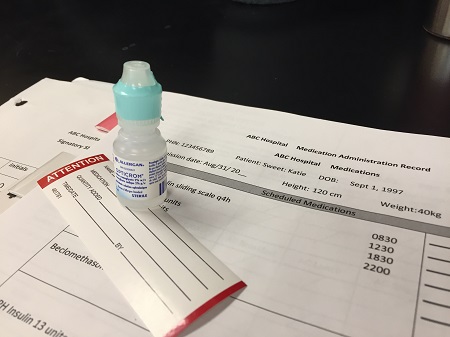 |
||
3. Take medications and MARs to the bedside.
|
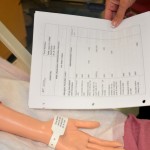 MARs cannot be taken into rooms where additional precautions are necessary. MARs cannot be taken into rooms where additional precautions are necessary.
The patient has the right to be informed. Drops may spill from the eye during administration. |
||
| 4. Wear clean, non-sterile gloves. | Using gloves protects the nurse from potential contact with patient body fluids and medications.
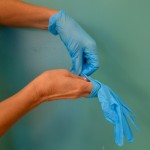 |
||
| 5. Cleanse the eyelashes and eyelids of any drainage or crusting with a warm washcloth or gauze. Use each area of cleaning surface only once, and move from inner to outer eye area. | Cleansing removes debris from eye area. | ||
| 6. Tilt patient’s head back slightly if patient is sitting up, or place patient’s head over a pillow (under the neck) if they are lying down. | Tilting the head back makes it easier to reach the conjunctival sac for instilling drops.
Do not tilt head back if patient has a cervical spine injury. |
||
| 7. Invert the eye-drop container, and have patient look up and focus on something on the ceiling. | Keeping the eye focused will help keep it still. | ||
| 8. Gently pull patient’s lower lid down using thumb or two fingers to expose conjunctival sac. | Place eye drop in conjunctival sac, not directly on eyeball (cornea). | ||
| 9. Eye drops: Hold eye-drop container above eye taking care not to touch the eye, eyelids, or eyelashes. Instill one drop, or more if prescribed, into conjunctival sac.
Eye ointment: Apply about 1.5 cm of ointment along lower conjunctival sac moving from inner to outer canthus. Twist tube to break off ribbon of ointment. |
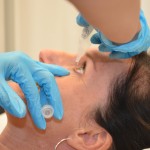 Touching the tip of the container to anything can contaminate the medication. Touching the tip of the container to anything can contaminate the medication. |
||
| 10. Release lower lid after instillation and ask patient to close eyes gently. Ask patient to move the eyeball while eyes are closed. | This step allows the medication to be distributed across the eye.
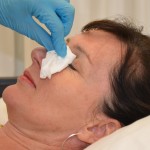 |
||
| 11. Eye drops only: Apply gentle pressure over inner canthus for 30 to 60 seconds to prevent medication from entering the lacrimal duct. | This minimizes systemic absorption and thus systemic effects of the medication. | ||
| 12. Instruct patient not to rub eye. | This is to prevent irritation and injury to the eye and to allow the medication to be fully absorbed. | ||
| 13. Remove gloves and assist patient to a comfortable and safe position.
Perform hand hygiene. |
This ensures patient safety and comfort.
Hand hygiene prevents the spread of microorganisms. |
||
| 14. Document as per agency policy. Include date, time, dose, route; which eye the medication was instilled into; and patient’s response to procedure. | Timely and accurate documentation helps to ensure patient safety. | ||
| Data sources: BCIT, 2015; Lilley et al., 2016; Perry et al., 2018 | |||
Instilling Ear Medications
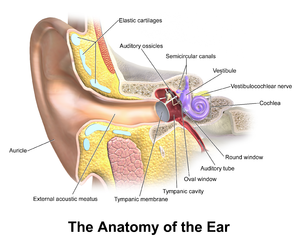
Common medications to be instilled into the ear include antibiotics, anti inflammatory agents, local analgesics, and wax emulsifiers (Lilley et al., 2016). In general, ear drops should be instilled after the ear has been thoroughly cleansed and the dropper cleaned with alcohol. Internal ear structures are particularly sensitive to temperature extremes. Therefore, ear (otic) medications should always be administered at least at room temperature but preferably at body temperature to promote comfort and to reduce risk of vertigo associated with cold ear drops (Lilley et al., 2016). Care must be taken to avoid contaminating the dropper and ear medication, as doing so could introduce microorganisms into the ear which could be very serious in the event the ear drum (tympanic membrane) is ruptured. After administration, the patient should be advised to lie on the unaffected side for 5 minutes to maximize medication absorption.
Checklist 50 outlines the steps for instilling ear medications.
Checklist 50: Instilling Ear (Otic) MedicationsDisclaimer: Always review and follow your agency policy regarding this specific skill. |
|||
Safety considerations:
|
|||
Steps |
Additional Information |
||
Check MAR to guide you to which medications you are preparing. Follow agency policy to ensure MARs are accurate and verified appropriately. |
 A MAR that is checked by more than one healthcare professional provides a very reliable record for administering medications. Agencies may vary in relation to MAR verification processes. |
||
2 a. As you are removing medications from the dispensing system, perform the SEVEN rights three times with each individual medication:
|
The right patient: Check that you have the correct patient using two patient identifiers (e.g., name and date of birth). The right medication (drug): Check that you have the correct medication and that it is appropriate for the patient in the current context. The right dose: Check that the dose makes sense for the age, size, and condition of the patient. Different dosages may be indicated for different conditions. The right route: Check that the route is appropriate for the patient’s current condition. The right time: Adhere to the prescribed dose and schedule. The right reason: Check that the patient is receiving the medication for the appropriate reason. The right documentation: Always verify any unclear or inaccurate documentation prior to administering medications. |
||
2 b. The label on the medication must be checked for name, dose, and route, and compared with the MAR at three different times:
|
 |
||
| 3. Before instilling ear drops, donne clean, non-sterile gloves. | Using gloves protects the nurse from potential contact with patient body fluids and medications.
 |
||
| 4. Cleanse external ear of any drainage using a warm wet washcloth. | Drainage or debris may prevent some medication from entering ear canal. | ||
| 5. If lying down, position patient on unaffected side with affected ear uppermost. Tilt head to side if sitting up. | Proper positioning helps to stop medication from escaping.
Do not tilt head if patient has a cervical spine injury. |
||
| 6. Draw up medication into ear dropper, ensuring correct dosage.
Do not return excess medication to stock bottle. |
Risk for contamination is increased if medication is returned to bottle. | ||
| 7. Adult administration: Gently pull ear pinna back and up.
Child (up to 3 years) administration: Gently pull ear pinna down and back. |
Pulling the pinna (the external part of the ear) straightens ear canal. | ||
| 8. Hold dropper tip just above ear canal. Do not touch dropper tip to ear. | Touching the ear with the dropper tip will contaminate the dropper and the medication. | ||
| 9. Allow drops to fall on the side of the ear canal. | Dropping the drops directly into the canal and onto the tympanic membrane will cause the patient discomfort. | ||
| 10. Release ear pinna and have patient remain in the position for at least 5 minutes. | This position prevents medication from escaping from ear. | ||
| 11. Apply gentle pressure to tragus (the inner side of the external ear) several times. |
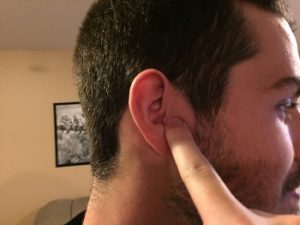 Pressure helps move medication toward tympanic membrane. |
||
| 12. If ordered, a cotton ball may be placed loosely in the ear canal. | Cotton ball helps prevent medication from escaping from ear. | ||
| 13. Remove gloves and assist patient to a comfortable and safe position. | This ensures patient safety and comfort. | ||
| 14. Perform hand hygiene. | Hand hygiene prevents the spread of microorganisms. | ||
| 15. Document as per agency policy. Include date, time, dose, route; which ear the medication was instilled into; and patient’s response to procedure. | Timely and accurate documentation helps to ensure patient safety. | ||
| Data sources: BCIT, 2015; Lilley et al., 2016; Perry et al., 2018 | |||
Instilling Nasal Medications
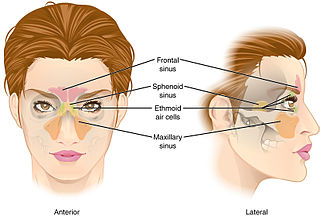 |
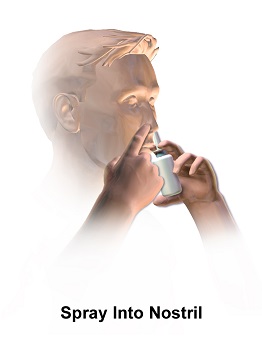 |
Nasal medications are instilled for the treatment of allergies, nasal congestion, and sinus infections. The nose is not a sterile cavity, but medical asepsis must be observed because of its connection to the sinuses. Prior to administering nasal medications ask the patient to gently blow their nose.
Following administration, burning may be felt. At this point blowing the nose is discouraged, as the medication has not had time to absorb. Depending on the purpose of the nasal medication, different positioning may help facilitate delivery of the medication to the correct sinus area.
Checklist 51 outlines the steps for instilling nasal medications.
Checklist 51: Instilling Nasal MedicationsDisclaimer: Always review and follow your agency policy regarding this specific skill. |
|||
Safety considerations:
|
|||
Steps |
Additional Information |
||
| 1. Perform hand hygiene prior to medication preparation. Check MAR to guide you to which medications you are preparing. Follow agency policy to ensure MARs are accurate and verified appropriately. |
 A MAR that is checked by more than one healthcare professional provides a very reliable record for administering medications. Agencies may vary in relation to MAR verification |
||
2 a. As you are removing medications from the dispensing system, perform the SEVEN rights three times with each individual medication:
|
The right patient: Check that you have the correct patient using two patient identifiers (e.g., name and date of birth).
The right medication (drug): Check that you have the correct medication and that it is appropriate for the patient in the current context. The right dose: Check that the dose makes sense for the age, size, and condition of the patient. Different dosages may be indicated for different conditions. The right route: Check that the route is appropriate for the patient’s current condition. The right time: Adhere to the prescribed dose and schedule. The right reason: Check that the patient is receiving the medication for the appropriate reason. The right documentation: Always verify any unclear or inaccurate documentation prior to administering medications. |
||
2 b. The label on the medication must be checked for name, dose, and route, and compared with the MAR at three different times:
|
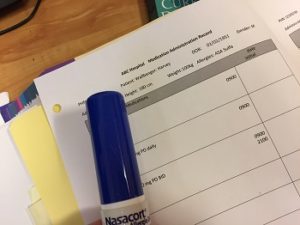 These checks are done before administering the medication to your patient. If taking drug to bedside (e.g., nose drops), do a third check at the bedside. |
||
| 3. Before instilling nasal medication, ask the patient to gently blow their nose.
Donne clean, non-sterile gloves. |
Nose blowing clears the nose prior to medication instillation.
Using gloves protects the nurse from potential contact with patient body fluids and medications.  |
||
| 4. Position patient.
Nose spray: Sitting upright with one nostril occluded, insert tip into open nostril. Nose drops: Position patient sitting back or lying down with head tilted back over a pillow (underneath neck). Draw fluid into medication dropper with enough for both nares. Do not return excess fluid into stock bottle. |
This position allows medication to flow back into nasal cavity.
Do not tilt head back if patient has a cervical spine injury. Returning fluid to stock bottle increases risk for contamination of medication. |
||
| 5. Instill medication:
Nasal spray: Have patient hold one nostril closed and breathe gently through the other as the spray is being administered. Spray should be directed away from the nasal septum. Repeat as directed. Nose drops: Hold dropper about 1 cm above naris and drop medication into one naris and then the other. Position patient with head back for 2 to 3 minutes. |
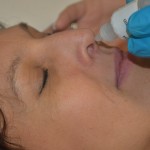 Maintaining position will help medications remain in place and maximize absorption. Advise the patient they may feel like something is in the back of the throat. This is medication dripping into the pharynx. |
||
| 6. Remove gloves and assist patient to a comfortable and safe position. | This ensures patient safety and comfort. | ||
| 7. Perform hand hygiene. | Hand hygiene prevents the spread of microorganisms. | ||
| 8. Document as per agency policy. Include date, time, dose, route; which naris the medication was instilled into (or whether it was both nares); and patient’s response to procedure. | Timely and accurate documentation helps to ensure patient safety. | ||
| Data sources: BCIT, 2015; Lilley et al., 2016; Perry et al., 2018 | |||
Critical Thinking Exercises
- Your patient is due to receive a dose of medication instilled into both ears. You find the ear medication stored in the refrigerator. How should you proceed?
- Your patient is due to receive medication instilled into her right eye, but you notice that her left eye has crusting and discharge. Discuss how you would proceed in this situation.
- You need to teach a patient how to self administer nasal spray for seasonal allergy symptoms. Describe the key points you will discuss with them.
Attributions
Figure 6.13. Anatomy of eye from OpenStax College, Anatomy & Physiology (2013) is used under a CC BY 3.0 license.
Figure 6.14. Drops with MAR by author is licensed under a Creative Commons Attribution 4.0 International License.
Figure 6.15. Anatomy of ear by Anatomy of the Ear by Blausen.com staff (2014) is used under a CC BY 3.0 license.
Figure 6.16. Massage the tragus after instilling ear drops by author is licensed under a Creative Commons Attribution 4.0 International License.
Figure 6.17. Nasal sinuses illustration from OpenStax College, Anatomy & Physiology. Used under a CC BY 3.0 license. Download for free at http://cnx.org/contents/14fb4ad7-39a1-4eee-ab6e-3ef2482e3e22@6.27.
Figure 6.18. Diagram of nasal spray application by BruceBlaus is used under a cc BY-SA 4.0 license.
Figure 6.19. Spray with MAR by author is licensed under a Creative Commons Attribution 4.0 International License.

